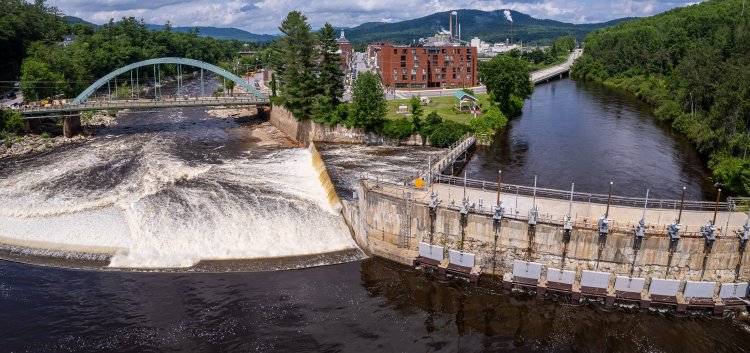
RUMFORD — A coalition of conservation groups is challenging a Maine Department of Environmental Protection water quality certification for the Rumford Falls Hydroelectric project.
Trout Unlimited and Friends of Richardson Lake were joined by American Whitewater, Maine Rivers, American Rivers and the Conservation Law Foundation to argue that the Rumford Falls Hydroelectric Project deprives a key section of the Androscoggin River of essential water flow, degrading aquatic habitat and diminishing ecological and recreational values.
The group claims the Maine Department of Environmental Protection should not have certified Rumford Falls Hydroelectric’s compliance with water standards in August 2024, which enables the Federal Energy Regulatory Commission to award Rumford Falls Hydroelectric its license to operate.
Rumford Falls Hydroelectric filed its application in September 2022; in October 2024 the agency authorized Rumford Falls Hydroelectric to continue operations until a license is issued. The commission has not yet granted the license and the Maine Board of Environmental Protection has not issued its final report.
The groups have requested a formal hearing before the Maine Board of Environmental Protection. Only a public comment session is scheduled for July 17. Should the Board of Environmental Protection recognize the appeal, it halts the licensing process, said Steve Heinz of Trout Unlimited, who pointed to the symbolic weight of the location.
“All of this is happening within sight of the Edmund Muskie memorial — (former U.S. Sen.) Muskie, of course, was instrumental in creating the Clean Water Act,” Heinz said. “So, it’s astonishing that in 2024, we have to explain to the Maine Department of Environmental Protection why rivers need water in their main channels.”
The coalition’s 30-page appeal argues that Rumford Falls Hydroelectric’s diversion of water through turbines at the Upper Dam leaves the main falls virtually dry for much of the year. Aside from the turbine flow, the dam releases water only one cubic foot per second through the spillway under most flow conditions. That level is inadequate to support fish, macroinvertebrates or other aquatic life, the appeal said.
“They’re not allowing more water flow on the upper dam,” said John Preble, a member and former director of Friends of Richardson Lake. “They pretty much dry out the flow down to the main falls.”
The bypassed section below the Upper Dam includes a 650-foot stretch of riverbed that could sustain fisheries, aquatic vegetation and recreational value, but only if water were allowed to flow through it, Heinz said. Currently, all but a trickle is channeled through the turbines, he said.

“They’re actually negatively impacting the migration of fish from the upper part of the river to the lower river,” Preble said. “It really forces any kind of wildlife to go through the turbines.”
The DEP’s certification found that Rumford Falls Hydroelectric met Class C water quality standards, but the groups dispute the finding, citing flaws in the underlying habitat and dissolved oxygen studies. The appeal also asserts that sections of the river weren’t properly surveyed, minimum flow assumptions were based on outdated or incomplete records, and the ecological value of the bypassed section of river was understated.
“They really went back, used old records and references, and never really studied that section of the upper reach of the Upper Falls as they would have been required to do for water quality and habitat quality,” Preble said, adding that safe downstream passage for indigenous species like American eels is impossible under the current configuration.
The groups are requesting the Maine Board of Environmental Protection reverse the certification or require new conditions, such as continuous minimum flow of 200 cubic feet per second over the Upper Dam’s spillway.
Rumford Falls Hydroelectric, operated by Brookfield Renewables, generates over 270,000 megawatt-hours of electricity per year and includes two dams less than a mile apart. While the turbines once powered a paper mill, Rumford Falls Hydroelectric’s electricity is now sold on the market.
“They hog every ounce of water there is,” Preble said. “It’s one of the largest waterfalls in the northeast being dry, you know, half the summer.”
A spokesperson for Brookfield Renewables did not respond to a request for comment.
Preble, who grew up paddling the Androscoggin, said the river has come a long way since the days when raw sewage was discharged directly into it.
“It used to be really a cesspool. … But now you can see right into the streambed — it’s nice, clean gravel,” he said. “In order to realize its full recreational potential, it’d be nice to have some minimal water flow for both the fishery health and the overall oxygen level.”
Heinz said years of keeping the falls from its full ecological potential is unconscionable. “We just don’t see how you can take all the water and run it through turbines, bypassing what is the largest waterfall east of Niagara, and still claim you’re meeting those standards.”

We invite you to add your comments. We encourage a thoughtful exchange of ideas and information on this website. By joining the conversation, you are agreeing to our commenting policy and terms of use. More information is found on our FAQs. You can modify your screen name here.
Comments are managed by our staff during regular business hours Monday through Friday as well as limited hours on Saturday and Sunday. Comments held for moderation outside of those hours may take longer to approve.
Join the Conversation
Please sign into your Sun Journal account to participate in conversations below. If you do not have an account, you can register or subscribe. Questions? Please see our FAQs.